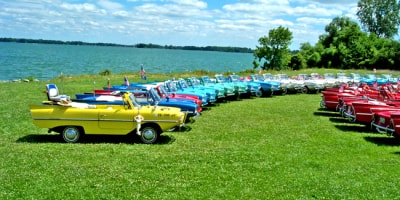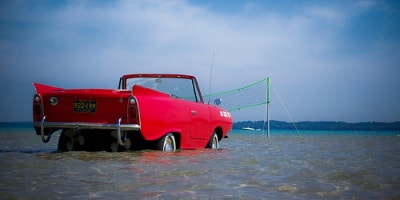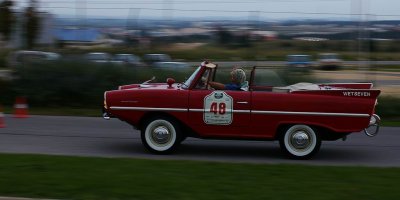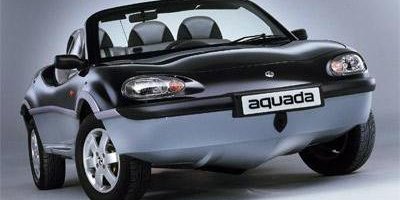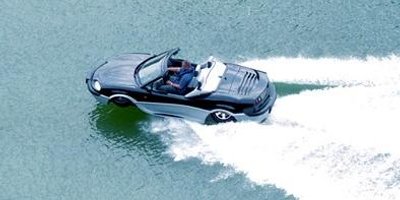We are not sure how many of you out there reading this know that, sometime in the history of the automobile, a strange hybrid vehicle crawled its way into the public eye, bringing with it a concept so simple no one really thought about it before.
It was called the Amphicar and, as the name suggests, it was an amphibious vehicle that could easily travel over land and through water. Considered by many the single mass produced non-military amphibious vehicle ever made and by few one of the ugliest vehicles of all times, the Amphicar came and went without creating the big waves it hoped for in the automotive puddle.
Of course, the whole thing had to start somewhere and, as you will see while reading this, it is not over yet. But let's take one step at a time.
THE IDEA: Orukter Amphibolus
The crazy idea of combining a road vehicle with a water-going one is about as old as the automobile itself. The first amphibious vehicle to hit both land and water allegedly surfaced in the early 1800s, when American Oliver Evans created a steam-powered contraption which managed to get driven well over a mile on the streets of Philadelphia and sailed on the Delaware River. The contraption was called Orukter Amphibolus and became the first amphibious steam carriage ever built. It was later put to use as a dock-cleaning dredge.
Nothing else notable happened on the civilian amphibious front until sometimes in mid 1910s, when William Mazzei came up with what he called the Hydromotor (or Hydrometer): a mid-sized car, propelled by a Continental engine and said to be capable of reaching 60 mph on land and 25 mph on water.
Mazzei's idea was picked up by George Monnot, who took it one step closer and created the Hydrocar, a combination between a boat, a car and a truck. This happened in the eve of the first World War and, once the war began, all the advancements achieved until then got swallowed by the war effort for military use.
THE FIRST: Schwimmwagen
The man credited with creating the first amphibious mass production vehicle is not an American, but German Ferdinand Porsche. During the war, Porsche created the so called Kubelwagen, the German equivalent of the American Jeep. Forced by the rigors of war, the bucket car, as the Kubelwagen was known, needed to be converted and made capable of traveling through water as well. Porsche converted it and the Schwimmwagen (swimming car) was born, considered by many the first mass produced amphibious vehicle in existence (albeit, for military use).
Porsche had his lead designer, Erwin Komenda, create an until-then-never-built body made of a unique bodytube structure for the amphibian. He then took the parts (including engine) from the Volkswagen Type 86 four-wheel drive prototype of the Kubelwagen and combined them into giving birth to the Schwimmwagen.
In the end, the amphibian was a 4WD vehicle, equipped with ZF self-locking differentials on both front and rear axles. To make the transition from land to water, the 4x4 dropped a screw propeller into the water, from the rear deck engine cover. Drive was ensured via a coupling directly to the engine's crankshaft. When in water, the front wheels became rudders, making the car as easy to drive in the water as it was on land.
THE REAL DEAL: Amphicar
The idea to create an amphibious vehicle for private use spawned in the mind of German national Hans Trippel sometimes after the end of the Second World War. Having been involved in the German war effort, Tripple got his hands on a Bugatti factory in France after the invasion and began building amphibious vehicles for the Wehrmacht.
When the war ended, Tripple took his vehicle manufacturing expertise and turned his sights on building small displacement vehicles. The business was not as successful as he would have wanted, so he had to rethink his entire strategy.
Taking advantage of his expertise with amphibious vehicles, Tripple began contemplating the idea of creating a car which could be sold to civilians, especially those, of course, in the US.
Tripple partnered with the Quandt Group to start the manufacturing of what he called the Amphicar, whose prototype was ready in 1959 and presented at the Geneva Salon the same year. Production of the vehicle began in 1961, with its creator expecting to sell around 20,000 units per year.
Amphicar came in the form of a two-door four-seat convertible, equipped with a folding cloth top. Dubbed model 770 due to the fact that it could achieve 7 knots on water and 70 mph (110 km/h) on land, the car was powered by a 1.2l four cylinder overhead-valve engine sourced from Triumph. To suit its water-going abilities, the engine was placed at the back, from where it could easily power the two nylon propellers fitted underneath the car. The engine produced 43 hp at 4,750 rpm.
As was the case with the Schwimmwagen, the Amphicar used its front wheels as rudders. They steered a body made up of a box-section steel sub-frame (parallel longitudinal members and five cross-members). Looked at from underneath, the body of the car looks like the hull of a boat.
To make it suitable for the two environments in which it is supposed to operate, the Amphicar employed land-and-water transmission built by Hermes, which allowed for the independent or simultaneous operation of the two propellers. For land, it had 4 gears plus reverse, while for water use it only had 2 gears.
As revolutionary as it seems (and you must admit, the concept is simply brilliant: imagine going to the sea side and not having to rent a boat for your off shore adventures), the idea never caught on. The 20,000 units sold per year envisioned by Tripple turned to dust as soon as Amphicar hit the water/road. The main reason behind this is the fact that the contraption was not as cheap as to encourage sales. Back in its glory days, it retailed for anywhere in between $2,800 and $3,300.
Another factor which led to its demise was the fact that the new EPA and DOT regulations came into effect in 1968, regulations which Amphicar could not meet. As the US represented about 90 percent of its global business, the company, Amphicar Corporation, was sent into disarray.
In all, the car stayed in production from 1961 to 1968, a period during which 3,878 units were built. When it went under, the remaining inventory of unused parts were purchased by Hugh Gordon, whose Gordon Imports is now the main source for Amphicar parts.
Even with its untimely demise, Amphicar will remain in history as the single car which managed to cross the English Channel, without being loaded on any boat.
THE FUTURE: Aquada
Unsuccessful as it was, the idea of a water-going car/road going boat didn't die out. Someone is at it again, this time with all the arsenal provided by the modern world. Gibbs Technologies, a Michigan based manufacturer, is currently working on several High Speed Amphibious technologies (HSA) to be used in such vehicles.
What they came up with so far, in terms of civilian use, is the Aquada, the result of a seven-year long research and development program. Unlike the Amphicar, the Aquada uses a jet propulsion system which, according to Gibbs, produces around 1 ton of thrust.
The Aquada uses a 175 hp V6 engine paired with a five speed automated transmission with reverse, as well as power assisted steering on both water and land. All the details you need about Aquada can be found in the PDF attached below.
It was called the Amphicar and, as the name suggests, it was an amphibious vehicle that could easily travel over land and through water. Considered by many the single mass produced non-military amphibious vehicle ever made and by few one of the ugliest vehicles of all times, the Amphicar came and went without creating the big waves it hoped for in the automotive puddle.
Of course, the whole thing had to start somewhere and, as you will see while reading this, it is not over yet. But let's take one step at a time.
THE IDEA: Orukter Amphibolus
The crazy idea of combining a road vehicle with a water-going one is about as old as the automobile itself. The first amphibious vehicle to hit both land and water allegedly surfaced in the early 1800s, when American Oliver Evans created a steam-powered contraption which managed to get driven well over a mile on the streets of Philadelphia and sailed on the Delaware River. The contraption was called Orukter Amphibolus and became the first amphibious steam carriage ever built. It was later put to use as a dock-cleaning dredge.
Nothing else notable happened on the civilian amphibious front until sometimes in mid 1910s, when William Mazzei came up with what he called the Hydromotor (or Hydrometer): a mid-sized car, propelled by a Continental engine and said to be capable of reaching 60 mph on land and 25 mph on water.
Mazzei's idea was picked up by George Monnot, who took it one step closer and created the Hydrocar, a combination between a boat, a car and a truck. This happened in the eve of the first World War and, once the war began, all the advancements achieved until then got swallowed by the war effort for military use.
THE FIRST: Schwimmwagen
The man credited with creating the first amphibious mass production vehicle is not an American, but German Ferdinand Porsche. During the war, Porsche created the so called Kubelwagen, the German equivalent of the American Jeep. Forced by the rigors of war, the bucket car, as the Kubelwagen was known, needed to be converted and made capable of traveling through water as well. Porsche converted it and the Schwimmwagen (swimming car) was born, considered by many the first mass produced amphibious vehicle in existence (albeit, for military use).
Porsche had his lead designer, Erwin Komenda, create an until-then-never-built body made of a unique bodytube structure for the amphibian. He then took the parts (including engine) from the Volkswagen Type 86 four-wheel drive prototype of the Kubelwagen and combined them into giving birth to the Schwimmwagen.
In the end, the amphibian was a 4WD vehicle, equipped with ZF self-locking differentials on both front and rear axles. To make the transition from land to water, the 4x4 dropped a screw propeller into the water, from the rear deck engine cover. Drive was ensured via a coupling directly to the engine's crankshaft. When in water, the front wheels became rudders, making the car as easy to drive in the water as it was on land.
THE REAL DEAL: Amphicar
The idea to create an amphibious vehicle for private use spawned in the mind of German national Hans Trippel sometimes after the end of the Second World War. Having been involved in the German war effort, Tripple got his hands on a Bugatti factory in France after the invasion and began building amphibious vehicles for the Wehrmacht.
When the war ended, Tripple took his vehicle manufacturing expertise and turned his sights on building small displacement vehicles. The business was not as successful as he would have wanted, so he had to rethink his entire strategy.
Taking advantage of his expertise with amphibious vehicles, Tripple began contemplating the idea of creating a car which could be sold to civilians, especially those, of course, in the US.
Tripple partnered with the Quandt Group to start the manufacturing of what he called the Amphicar, whose prototype was ready in 1959 and presented at the Geneva Salon the same year. Production of the vehicle began in 1961, with its creator expecting to sell around 20,000 units per year.
Amphicar came in the form of a two-door four-seat convertible, equipped with a folding cloth top. Dubbed model 770 due to the fact that it could achieve 7 knots on water and 70 mph (110 km/h) on land, the car was powered by a 1.2l four cylinder overhead-valve engine sourced from Triumph. To suit its water-going abilities, the engine was placed at the back, from where it could easily power the two nylon propellers fitted underneath the car. The engine produced 43 hp at 4,750 rpm.
As was the case with the Schwimmwagen, the Amphicar used its front wheels as rudders. They steered a body made up of a box-section steel sub-frame (parallel longitudinal members and five cross-members). Looked at from underneath, the body of the car looks like the hull of a boat.
To make it suitable for the two environments in which it is supposed to operate, the Amphicar employed land-and-water transmission built by Hermes, which allowed for the independent or simultaneous operation of the two propellers. For land, it had 4 gears plus reverse, while for water use it only had 2 gears.
As revolutionary as it seems (and you must admit, the concept is simply brilliant: imagine going to the sea side and not having to rent a boat for your off shore adventures), the idea never caught on. The 20,000 units sold per year envisioned by Tripple turned to dust as soon as Amphicar hit the water/road. The main reason behind this is the fact that the contraption was not as cheap as to encourage sales. Back in its glory days, it retailed for anywhere in between $2,800 and $3,300.
Another factor which led to its demise was the fact that the new EPA and DOT regulations came into effect in 1968, regulations which Amphicar could not meet. As the US represented about 90 percent of its global business, the company, Amphicar Corporation, was sent into disarray.
In all, the car stayed in production from 1961 to 1968, a period during which 3,878 units were built. When it went under, the remaining inventory of unused parts were purchased by Hugh Gordon, whose Gordon Imports is now the main source for Amphicar parts.
Even with its untimely demise, Amphicar will remain in history as the single car which managed to cross the English Channel, without being loaded on any boat.
THE FUTURE: Aquada
Unsuccessful as it was, the idea of a water-going car/road going boat didn't die out. Someone is at it again, this time with all the arsenal provided by the modern world. Gibbs Technologies, a Michigan based manufacturer, is currently working on several High Speed Amphibious technologies (HSA) to be used in such vehicles.
What they came up with so far, in terms of civilian use, is the Aquada, the result of a seven-year long research and development program. Unlike the Amphicar, the Aquada uses a jet propulsion system which, according to Gibbs, produces around 1 ton of thrust.
The Aquada uses a 175 hp V6 engine paired with a five speed automated transmission with reverse, as well as power assisted steering on both water and land. All the details you need about Aquada can be found in the PDF attached below.







